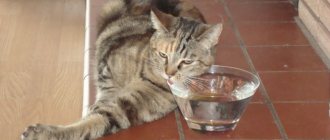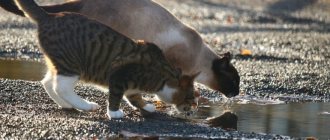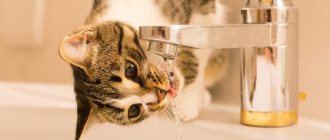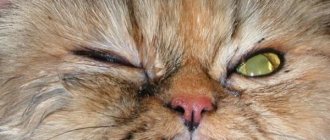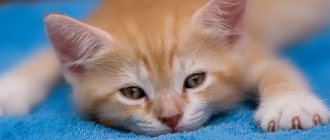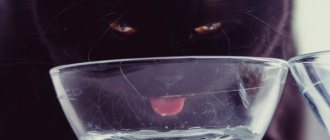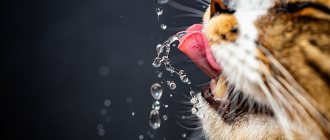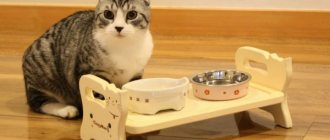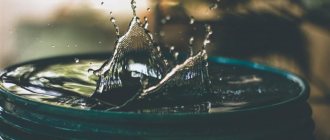- Add something tasty to the water
If your pet eats wet food, he usually does not need water. He can get all the necessary liquid from food . If the cat “sits” on dry land, water is vital for him. But what if the mustachioed man doesn’t touch his bowl? Of course, look for reasons. Well, if they don’t work, resort to tricks. In this post we will talk about both.
Before you figure out the reasons why your pet won’t touch the water, we advise you to consult a veterinarian. Dehydration can cause a lot of problems for a cat's health, but for kittens it is critical. So act without delay.
What water to give a kitten
The smell and taste of water seem incomprehensible and strange to the kitten, because they do not resemble mother’s milk.
A small cat does not need to explain the need for moisture for the body, so teaching it to lap from a bowl is not difficult
This causes difficulty in bowl training small cats. But moisture plays an important role in the growth of the pet’s body, so you need to be careful when choosing it. A high-quality drink will help the kitten quickly get used to lapping from dishes.
Attention! Boiled water is not healthy for animals.
Tap water may contain chlorine, which can repel and harm animals. Boiling will not help get rid of harmful compounds; it will increase their concentration. Due to poor quality liquid, a small cat will not be able to get mineral elements. Your pet will be at risk of developing urolithiasis.
Bottled or filtered tap water contains the necessary elements to support metabolic processes . It is already ready for consumption and does not need to be cleaned.
The Mind of Pets
Before we actually talk about how to get a kitten to drink water from a bowl, it's a good idea to know what causes felines to neglect water in the water bowl.
© shutterstock
In case you don't know, feral cats get their moisture through the flesh of their prey (rodents, birds, etc.), which means they rarely have to drink water. Although modern cats have abandoned many of the traits of their ancestors, they retain some characteristics, including their drinking habits. Unfortunately, on such days, kittens tend to get less moisture from their food, especially if they are given dry food. Thus, without proper habit correction on the part of humans, dehydration is the end result for pets.
Also, if kittens need to drink water, some will only drink from a moving source. In the minds of pets, they think that standing water will make them sick. So kittens don't pay attention to their bowl and instead hang around the sink to get water from the tap. It's also possible that kittens favor moving water simply because it's fun: catching drippings from the tap is a great way for bored cats to pass the time. Alternatively, kittens may enjoy cool, moving water (tap water, rain water, etc.).
How to teach a kitten to drink water from a bowl or jar
Many owners don’t know how to teach a kitten to drink water from a bowl; they try to poke it with its muzzle into the container , but this scares the pet. Use tall, dark dishes that won't confuse your cat with bright colors.
Bottled or filtered tap water contains the necessary elements to support metabolic processes
Try to entice them with a game: sprinkle a few drops with your fingers or a spray bottle. The kitten will become interested in splashing water, water circles in a bowl, and out of curiosity wets its paw into the container.
This may frighten him, but try to reassure your baby that the liquid in the bowl is safe. Repeat the above methods, then he will get used to the bowl.
Attention! If the kitten is vomiting severely, you will have to force liquid into it using a syringe to prevent dehydration.
Another option will also help accustom your cat to the bowl: use catnip. Place the container on a cloth soaked in the liquid extract, and the cat will not remain indifferent to its smell. Try not to overdo it with mint: animals' sense of smell is much more subtle than human perception of odors.
The easiest way is to arrange dishes of different shapes and observe which bowl the kitten pays more attention to. Most importantly, don't stand next to him and don't force him to drink. Your presence can distract the cat or frighten it.
Important! Often cats drink water from the shower or sink because they are interested in it.
When to see a doctor
In some cases, an animal’s refusal to drink water is due to various diseases. Associated symptoms here may be lethargy and apathy. If poisoned, the animal may suffer from diarrhea or vomiting.
In this case, the kitten must be given water from a pipette or syringe to avoid dehydration. Some cases require a veterinarian to make an accurate diagnosis and teach breeders how to properly address dehydration.
Let's summarize: for full development it is important that the kitten consumes enough water. If there is a problem in getting used to drinking plain water from a bowl, it is important to understand the cause. If the baby has not yet learned the ability to drink properly from his mother, he needs to be taught how to do it. If the kitten does not like the quality of the water, it is worth observing its preferences and making the necessary changes, and in case of dehydration caused by illness, it is necessary to visit a veterinarian and undergo a course of treatment in accordance with his recommendations.
Source
Why does a kitten not drink water well?
A kitten's refusal to drink may indicate that its teeth are changing. This occurs when the animal reaches 3-5 months. The kitten tries not to touch the loose tooth, so it is difficult for him to lap up liquids. Severe pain can cause your pet to eat less of any food. It is better to teach a kitten to drink water before the age of 3 months.
When kittens begin teething, they experience severe itching in their gums and chew on objects. If something gets stuck in a cat's throat, he will not be able to swallow normally and will refuse to drink. Try not to leave small objects on the floor - kittens will definitely try them.
Attention! Wet food already contains a certain amount of water, so the kitten may drink less if it eats spiders.
What kind of water is best to give to a cat?
Tap water is the simplest and most harmless option. But it must be cleaned before being consumed. Many owners of aqua filters forget that the device needs to be constantly changed.
Filters wear out and stop doing their job. To clean the liquid from harmful substances, you can leave it in a tightly closed container for 6-8 hours. Running water contains a lot of oxygen; it attracts pets more than bottled or boiled water. This is why many cats love to climb into aquariums: they are always equipped with devices that saturate the water with oxygen.
Drinking fountains are an expensive pleasure, but this device is the most convenient and better purifies the liquid from harmful impurities. The liquid in such devices constantly circulates, enriched with oxygen and cleansed of harmful impurities. Some drinkers have a dome with a hole at the top.
It will be convenient for your pet to lick the dripping liquid. Veterinarians say that using a drinking fountain can quickly teach a cat to drink water.
Many owners, trying to please their pet, aggravate its condition. Boiling rids the liquid of parasites and the smell of chlorine. But when it evaporates, the concentration of salts increases. The resulting sediment mixes with the water and makes it “heavy.” Such drinking will not benefit the animal.
If you are concerned about the health of your family and pets, it is easier to buy bottled water. It's more expensive than pouring it from the tap. But bottled water reaches customers completely purified from harmful substances and parasites.
By looking at reviews, you can be convinced of the quality of a product of a particular brand. You cannot always be sure that the filters are working properly; they need to be constantly changed. Buying bottled water can be even more cost-effective than constantly changing purification devices.
How to determine if your cat drinks enough fluid per day
Animals have the same problems as humans when they don't get enough fluids. Cats may not get the moisture they need for a variety of reasons, but owners should closely monitor their pet's health.
The following signs may indicate your pet's condition:
- Skin elasticity . Your pet's skin becomes dry and stiff if he doesn't drink enough fluids. Normal dermis quickly regains its shape if you grab the cat's scruff and pull.
- Condition of the coat. It is worth sounding the alarm when the cat’s fur loses its shine and begins to fall out. If the animal does not have parasites or allergies to the selected diet, then the problem may lie precisely in the lack of moisture. When a pet's coat is shiny, it makes it clear that its health is not in danger.
- Physical activity. Without the necessary moisture, the cat becomes inactive, reacts sluggishly to calls, and does not want to play.
- Frequency of urination . If an animal urinates less than 2 times a day, this is a sign of ill health.
How do you know if your cat needs veterinary help?
Usually you can cope with this problem yourself; you just need to move the feeder away from the drinking bowl or change the contents of the latter more often. If your four-legged pet refuses to drink or does it too rarely, and there are other suspicious symptoms, you cannot ignore them. Such carelessness under unfavorable circumstances can cause the death of an animal. You should immediately show your cat to a veterinarian if:
- she has completely or partially lost interest in food;
- the four-legged friend's behavior has changed (he has become lethargic, apathetic, does not respond to external stimuli, spending most of his time in a lying position or, on the contrary, is restless and aggressive);
- the cat feels sick and vomits;
- your pet has diarrhea or constipation;
- the animal's body temperature has increased;
- your four-legged pet has bad breath;
- the cat is losing weight;
- there are foreign inclusions in the cat’s feces or urine in the form of mucus and blood;
- the consistency of feces has changed, they have a foul odor;
- the cat has decreased the number of urinations;
- the mucous membranes of the animal acquired a jaundiced tint.
These are just a few possible suspicious symptoms that require immediate attention to your veterinarian. A sick pet may have other warning signs.
The cat doesn't drink water.
#1 Omi
- Participants+
- 6 messages
- Administrators
- 15,540 messages
- Regular visitors
- 2,255 messages
#2 Felina
Is the food wet or dry? Cats can get enough water from wet water so that they don't have to drink too much later.
#3 Sestratk
Cat Soul Healer
A cat that does not drink water should absolutely not be fed dry food. How to train it - here is the article: A cat can live much shorter without water than without food. A cat can “save” water by highly concentrating its urine, which can lead to the formation of stones in the urinary tract. Therefore, it is very important that your cat gets enough water.
In temperate climates, a cat should drink 40-60 ml of water per kilogram of weight daily. The main losses of fluid from the body occur in saliva, feces and urine. The worse the food is digested, the greater the loss of water in feces.
A cat gets water from two sources: from drinking and food. Wet food and natural food contain up to 80% liquid, so cats on this type of feeding usually drink little. If a cat eats super-premium quality dry food, then it must drink two, or better yet, three times more water than the food it eats. This is a necessary condition for food to be used for good and not harm.
What to do if your cat drinks little? You can supplement it with water every day from a syringe without a needle into the corner of your mouth. But you can try to follow some recommendations.
— The “food” area should be as far as possible from the “toilet” area.
— Bowls for water and food should be kept at a distance from each other.
— It is better to use bowls made of stainless steel, earthenware or polypropylene.
Place water containers of different shapes and sizes in different places and watch your cat. Our little individualists often surprise us: some are served almost in a basin on the floor, some agree to drink only from a mug, others prefer tap water.
Instead of tap water, you can offer your cat a drinking fountain. A bright bowl with an anti-slip coating can also attract your cat's attention. You can try to lure the cat to the bowl with a game: pour water from one container to another, put bright toys or pieces of treats into the water: in all available ways, strengthen the connection between water and pleasant associations. Try it - it works!
At one time, I spent quite a lot of effort trying to teach a very light-drinking cat to drink the required amount of water. My cat drank so little that she even became dehydrated and I had to supplement her with a syringe.
How I taught my cat to drink
My first purebred cat came to live with me when she was 4.5 months old. She quickly adapted and everything was fine, only my cat didn’t drink enough. I’ll put her next to a bowl of water, she’ll lick the water a few times, and that’s it. I thought that nature cannot be fooled and a cat cannot die from lack of water next to a full bowl. I was wrong.
When she got sick, I saw for the first time that she was quite capable of actively lapping up water. But, after recovery, the cat stopped drinking again. At best, she was playing with water.
At first I cooked her cat “soup”, when we switched to drying, I soaked the dry food with the prescribed amount of water (15 g of water per 5 g of drying). And she also fed it from a syringe. But I was haunted by the thought that she knew how to drink, but didn’t drink. And few people would agree to give a cat that doesn’t drink extra food on purpose if I suddenly have to leave. A cat cannot live without water! And I decided that the situation urgently needed to be corrected. Moreover, the cat is young and you can try to teach her to drink on her own.
Experienced people advised to try different dishes for water. In my kitchen there are several bowls of different sizes, a plate, and a jug. I poured water from the jug into the bowl and back, played with her pussy, wet her nose - she was happy to communicate, happily played with the surface of the water, even bit it, but did not drink! We continued to drink from a syringe. And then I thought: why would my cat drink on her own if she already has enough water? I soak the food and feed her some more!
The most important stage has begun. I stopped soaking the food. After giving her pussy a drink at night, she poured some “crackers” on it in the morning. But the bowl of water still did not arouse her enthusiasm. But the kitty began to greet the syringe with water with joy: she reached out to it with her muzzle, made lapping movements with her tongue, and opened her mouth herself. It became very easy to finish drinking it! This is what I decided to take advantage of. First I tried pouring water into a bowl from a jug. Kitty began to bite the stream and began to try to drink. But a trickle from a jug is also not very convenient, and we are terribly afraid of the tap! Then I decided to take advantage of her trust in the syringe.
Seeing a syringe with water, the pussy joyfully ran towards it. I showed her that there was water in the syringe: I splashed or scooped water from the syringe into a bowl of water. I squeezed a drop of water onto her nose and she licked her lips. The syringe was brought closer to the bowl of water, a stream was released from it, which the kitty caught with her tongue. And then I put the syringe in a bowl with the tip on the side. And it worked! My girl tried to get the syringe out with her paw, but she couldn’t, and it was wet. How to catch it with your mouth? - He's in the water. Lick the water, lick it - that's what you need. And I’m nearby, petting her and praising her.
Deviations in water consumption
You should not hesitate if the cat does not drink water or is interested in water but cannot lap. If an animal refuses water for more than 20 hours, it becomes dehydrated.
Please note that refusing food (if the cat drinks) for less than a day can be considered normal, since cats sometimes tend to have fasting days
If the cat sniffs water (broth, milk) and tries, but cannot drink, you should also contact the clinic without delay. It is worth understanding that dehydration is a very dangerous condition, and it can develop against the background of several factors:
- The cat doesn't drink.
- Attacks of severe diarrhea or vomiting.
- Kidney pathology or failure to absorb water for other reasons.
A sharp increase in the volume of water you drink also does not bode well. If you notice that the cat is emptying the bowl and asking for more, you need to be wary. There are two options for the development of events:
- The cat drinks a lot and urinates little, the urine is rich in color and has a strong odor, sometimes with blood - the animal develops edema, apathy occurs, and food refusal occurs. Most likely, the cause is liver pathology, cystitis, deformation of the ureters, blockage of the urethra and or urolithiasis. The condition is accompanied by intoxication with general symptoms of poisoning.
- The cat drinks a lot and urinates a lot, the urine becomes light yellow and has a faint odor - a symptom indicating active (increased) kidney function. The reason may be diabetes, pyometra (purulent inflammation of the uterus), high body temperature, or the development of a viral or other disease.
Important! If a cat does not drink in the heat, this is a very dangerous condition! Contact a veterinary clinic immediately!
https://porodakoshki.ru/skolko-vody-dolzhna-pit-koshka/https://candycat.ru/pitanie-gigiena-son-u-koshek/potreblenie-vodyi-koshkami.htmlhttps://zveridoma.ru/ skolko-vody-dolzhna-pit-koshka-v-sutki-norma-i-otkloneniya/
The cat doesn't drink from the bowl!
In the power of instincts!
In the wild, cats drink water from ponds. Whenever possible, they choose flowing ponds and streams with clean, cool and fresh water. They also never eat where they drink, and vice versa. These habits are firmly enshrined in the genetic memory of everyone, including domestic cats. By knowing about them, you will better understand your pet's behavior.
Why does a cat drink tap water?
The vast majority of domestic cats around the world would gladly trade a bowl for a constantly running tap. But since you and I cannot afford such extravagance, they can only make do with little: drink from a bowl (the owner’s mug, aquarium, bucket or even toilet!) and catch moments when the water is turned on.
Why do cats drink tap water? Do you feel similar to a stream? Tap water is constantly in motion, it is clean, fresh and cool - just like in nature. You can also play with it with your paw! How can I resist here?
Why don't cats drink from a bowl?
Here are the main reasons why your pet may ignore the bowl.
1. The bowl is not suitable for the cat. If the bowl is too small or too large, your pet may justifiably refuse it.
2. The bowl is made of low-quality material. Such material can smell (if you don’t smell it, you can’t say it doesn’t exist: cats’ sense of smell is much more acute). In addition, it scratches and cracks easily. The damage collects dirt and microbes, which leaves its mark on the taste and quality of the water poured.
3. The bowl is in the wrong place. Some cats refuse to drink from double bowls or bowls placed next to food. In such cases, food may get into the water, it will smell differently, and in nature, cats never drink where they dine.
Do not place bowls in high-traffic areas, in drafts, near toilets, household chemicals or noisy equipment. All these and many other factors will not encourage your pet to drink.
4. Each pet should have its own bowl. If you have several cats or a dog in your home, choose different bowls for them. For a self-respecting cat to use a “reservoir” from which a dog has just drunk is blasphemy!
5. Questionable water quality. We saved the most important point for last. Most often, cats refuse to drink from a bowl because the owner doesn’t wash it well or rarely changes the water.
The bowl should be washed thoroughly every day. Preferably, without using detergents so that there are no odors left on it. The water is changed once or, better yet, several times a day. Are you following these rules?
Drinking plenty of fluids is essential to maintaining health, and a cat's refusal to drink from a bowl should not be ignored. Some owners will decide that there is nothing wrong with such behavior: they say, he will drink from the aquarium if he wants. But such water, just like tea from your mug, will not be beneficial for the cat and will not satisfy the body’s need for moisture. The cat should drink clean, fresh water at room temperature and have access to it at all times. Be careful!
How to train a cat to drink water from a bowl?
– place the bowl in a suitable place (not near food, household chemicals, noisy equipment and litter tray, not in a draft or on the aisle),
– wash the bowl regularly,
– change the water at least once a day,
– do not allow several animals to drink from the same bowl.
The ideal option is several bowls in different parts of the apartment. Most importantly, do not forget to change the water in them. When the cat decides on its favorite “watering holes”, other bowls can be removed.
Tell us, how are your pets doing with drinking?
Organize the right place for a watering hole
Sometimes a cat drinks little water only because the water bowl is in the wrong place and there is no alternative.
Water should not be near food
The most common misconception among owners is to place a bowl of food and a bowl of water next to each other, or even use a double bowl. Drinking where they have eaten is not typical for cats; in nature, a watering hole is always located at a distance from the hunting area. And this instinct is still relevant: if a pellet of food or a piece of meat falls into a bowl of water, it will instantly deteriorate, becoming undrinkable. How quickly the owner will discover the problem is a big question.
Water should not stand near the tray
No comment here - neither water nor food should be near the cat's litter box. Cats are clean animals; they carefully bury their excrement, prefer to use a litter tray with fresh litter, and are disdainful of eating near their own litter box.
It's funny, but a human toilet may seem like a good source of fresh water to a cat - far from the kitchen, in a secluded place, on a hill. The danger is that the cat can be poisoned by detergents due to the owner’s oversight.
Image is nothing, thirst is everything!
There must be several sources of water
Cats are extremely sensitive to hunger, but can ignore thirst for a long time. Therefore, there should be several bowls, taking into account the size of your home - for a small apartment this is at least three watering places.
The water should be in the path of the cat's usual route. Observe where your pet likes to rest and play (woke up, drank and only then ran to eat).
A cat's laziness knows no bounds, just take it for granted that your cat will not specifically go looking for water to drink.
Water on a hill
In the wild, the higher the water, the cleaner it is. Cats strive “to the source of the river,” ignoring the water that is in a flat bowl on the floor. Sometimes it is enough to place a deep bowl on a raised surface (window sill, table) to get your pet interested in water. Many cats like to drink from the tap not because there is running water. The sink is just high enough.
Oh, water, good luck. Whatever I don’t finish, I’ll spill
If you place a drinking fountain on the floor, it will be less attractive than a water tap. It is better to place high containers on the floor: a bucket, basin, pan.
Bobtail drinks from a bucket
What to do if your cat doesn't want to drink water from the bowl
Any cat, like any other animal, needs to drink enough fluids to maintain its health at an appropriate level. For this reason, every owner should ensure that their cat receives enough fresh and clean drinking water.
However, very often the owner notices that the water in the cat’s bowl practically does not decrease, and the cat does not want to approach it. But you can often see her next to the water tap in the bathroom or kitchen, or you can catch her drinking water from an aquarium or some other place.
How to create the right conditions
Often, owners are faced with a situation where a kitten drinks water, but not where the bowl was placed. In the right place, the liquid remains untouched, and the pet has adapted to drink water from the tap, in the toilet or other place. Understanding the reasons will allow the owner to change the situation and teach the kitten to drink where it is supposed to :
- From early childhood to old age, cats are considered clean creatures. Therefore, they are disdainful of drinking water if it is poured into dirty dishes or if it sits there for a long time. This is one of the reasons why you should not place water near food. This way, drinking liquid becomes contaminated much faster. And the animal is unlikely to want to drink it.
- Cats react quite acutely to odors. Low-quality raw materials can not only have a color or smell that is unattractive to your pet, but also release toxic substances into the water. Therefore, if the bowl is made of cheap and low-quality material, the kitten may refuse to drink from it altogether. Moreover, such liquid becomes dangerous to his health.
- Sometimes the reason why an animal refuses water can be due to the increased content of chlorine in it. If this happens, you should replace the tap water with settled or filtered liquid.
When the problem is caused by unfavorable conditions, it will not be enough to simply force the kitten to drink. In this case, you should first observe your pet and see what method he chose to consume the liquid. And then, based on his preferences, choose the necessary container to teach the kitten to drink water from it.
What kind of water do cats like most?
Most of all, cats love running water - cool, clean and fresh. Cats living in natural conditions prefer water from rivers and streams, avoiding muddy stagnant ponds and puddles, where various parasites and bacteria are always found in abundance.
It is for this reason that the cat begins to instinctively look for some larger body of water in the house, for example, an aquarium, a bucket or a bathtub. Often, cats who love running water express their preference by trying to drink water from the tap.
Of course, not every owner can afford to leave the water tap in the sink slightly open for their pet. However, such people could use not standard water bowls, but a special water bowl for a cat made in the form of a fountain or waterfall. Cats are delighted with such drinking bowls, however, they are quite expensive, and not every owner will be able to afford to purchase such a drinking bowl.
Therefore, you need to accustom your cat to a bowl of water, from which it can meet all its fluid needs. All you need to do is follow a number of recommendations, following the rules for drinking a cat from such containers. First, you need to consider the reasons why a cat may refuse water from a bowl.
Water consumption rate
Let's figure out how to calculate the amount of water a cat should drink per day? The daily norm is calculated in several ways, and its fluctuations depend on the weight of the animal and the type of food it eats. You need to understand that the indicator obtained during the calculation process is not the absolute truth for each individual animal. The resulting volume of liquid is a guideline, that is, if the cat begins to drink more or less, it needs to be shown to a doctor or at least carefully monitored.
According to generally accepted rules, the daily water intake is calculated based on weight, namely: 20–40 ml per 1 kg of weight. Some veterinary reference books indicate slightly different information: the rate of water consumption is 50 ml per 1 kg of weight per day. Kittens drink a little less, adult cats drink more.
Some recommendations apply to animals that eat only dry food. The daily water intake should be twice the weight of the food eaten. That is, if a cat eats 150 grams. granules, she should drink at least 300 ml of water. This indicator is not justified from a practical point of view if the cat is kept on high-quality food that does not contain salt.
When calculating your daily water consumption, you need to take into account one more nuance, namely the type of food. We talked about dry food above, but if a cat eats natural food, the amount of water it drinks may decrease if the cat receives milk, broths, canned food with gravy and other wet food.
Factors influencing water consumption
Having calculated the daily water intake for a cat and discovered that the pet does not drink it (or drinks more), you need to take into account several more factors. The fact is that a cat drinks according to its needs, no more and no less. At the same time, there are a number of ailments that increase thirst or cause the cat to refuse to drink.
Unless sick, your cat may consume more water for the following reasons:
- Hot weather - the cat becomes thirsty as natural fluid loss increases.
- Dry air - thirst increases as the mucous membranes quickly dry out.
- Pregnancy - the mother's body constantly produces additional blood and amniotic fluid.
- Rehabilitation after childbirth and lactation - the cat should drink a lot more water, since excessive fluid consumption leads to dehydration.
A sharp decrease in water consumption or temporary refusal of it may be associated with:
- Rehabilitation after surgery - after recovering from anesthesia, the cat may refuse water. In this case, the mouth must be forcibly wetted, but there is no need to fill it with water. After long operations, it is sometimes necessary to put drops in the eyes and nose (to moisturize).
- Dampness – the cat loses less moisture.
How can this problem be solved?
First we need to discuss water quality. Cats will always prefer fresh, clean water to stagnant or cloudy water. Therefore, the water should be changed daily or even several times a day - it will only be better.
We must not forget that the water in the bowl can become contaminated not only from dust or the ingress of some foreign objects, but also from cat saliva, which gets there in sufficient quantities after the first drink.
If a dog lives in the house with a cat, then it will probably drink from the same bowl, which can also affect the cat’s attitude towards such water. In this case, you should block the dog's access to the cat's drinking bowl. For example, a bowl can be placed on a windowsill.
One of the unsuccessful options for a water container is a double bowl into which both food and water are poured. In bowls with a similar device, food particles often fall into the water, contaminating it. The same thing happens when the water bowl is too close to the food bowl. Also, you should not use the same bowl for eating and drinking; in other words, the drinking bowl must be a separate container.
Care should be taken to ensure that the water does not contain any impurities and does not have any repulsive odors. Perhaps you should refrain from using various detergents and cleaning products, since they leave odors that the cat will not necessarily like. Although it can be argued that she will not like them for sure.
About where the bowl of water should be located
The drinking bowl should not be located near washing powders, cleaning gels and similar household chemicals. Also not suitable are those places in the hallway where shoe polish will be located near the drinking bowl. Water can easily absorb the odors of these intensely scented products and become unsuitable for the cat.
How to train a cat to drink only from a bowl.
Under no circumstances should you place a water bowl near the cat's litter box - cats will not eat or drink water near the place where they defecate.
What should a water bowl be like?
You should immediately realize that bowls made from cheap, low-quality plastic often have an unpleasant odor. A person may not feel it, but for cats this aroma will be quite obvious, and they may refuse to drink from such dishes. The same can be said about metal bowls, the smell of which also very often does not cause much delight in cats.
Glass and ceramic containers, large and wide, are best suited for watering cats. In such bowls, water remains fresh for a longer period, and glass and ceramics are odorless.
